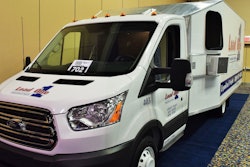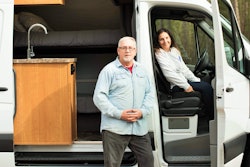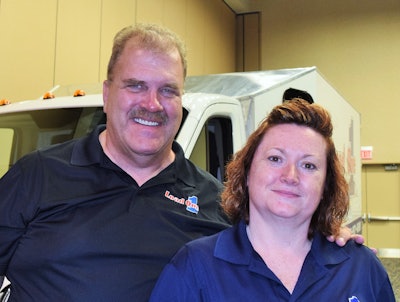 Small fleet owners Steve and Carol McNeal
Small fleet owners Steve and Carol McNealAt the Expedite Expo last year, West Michigan Expedite small fleet owner Steve McNeal, with his business leased with Load One, outlined a set of cargo-van-hauling basics for attendees in a session he prefaced by noting there are many ways to upfit a cargo van. In the session, though, he focused on ways to combat what is an essential issue for drivers of vans in expediting — comfort on any layover away from home. With his presentation, he shared this list of the pieces of equipment he detailed for use to set up an operation to save money, ultimately, while remaining as comfortable as possible in the small interior spaces a van affords. A round-up of McNeal’s talk follows as well, with some further elucidation of points from my talk with him earlier in the year ahead of this month’s feature on cargo van expediting and other downsizing-related van topics. If you missed that feature, find it here:
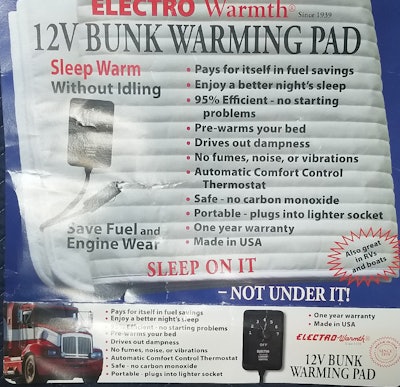 This heated mattress pad available via ElectroWarmth runs on 12-volt power and retails for just more than $130 for most single sizes.
This heated mattress pad available via ElectroWarmth runs on 12-volt power and retails for just more than $130 for most single sizes.1. Heated mattress pad by Electro Warmth
Rather than a fairly common electric blanket for cold temperatures on overnights in winter, McNeal says this 12-volt-powered heated mattress pad “operates on almost zero electricity, and will go all night and keep you toasty warm” combined with a blanket, and without draining your house battery, about which:
2. Deep-cycle house battery
The battery will not replace your charging battery, McNeal says. “We use the Odyssey,” detailed in the pdf document as Model 31R-PC2150, which is “warrantied for four years.”
“You can use a manual switch or an automatic switch” to isolate the battery so that downtime power needs don’t drain your starting battery, McNeal says. Set up properly, automatic switching systems will audibly click in when you start the van. “If you’re not comfortable with electricity or don’t know what you’re doing,” the auto system can help increase comfort levels, and “work great for a year or year and a half” before failing, in McNeal’s experience, which you’ll know when the click is no longer heard.
He prefers manual switches, personally, he says, because they afford operators the ability to “jump” from the house battery if the starting battery fails. “You never have to worry about a dead starting battery.” Further details on necessary circuit breakers and the switches are available in the pdf.
In the Ford Transits he owns, the house batteries typically “sit right behind the driver’s seat,” McNeal says, in the Ram Promasters “in the floor in front of driver’s seat.” McNeal does invest in a plastic enclosure for them.
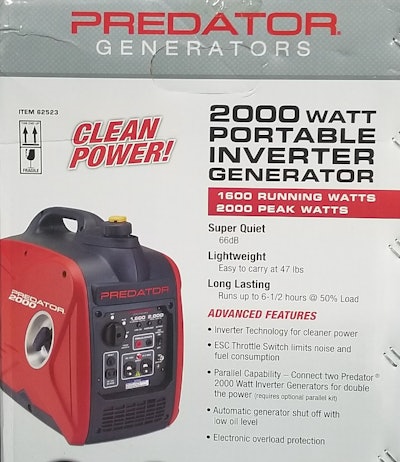 Generator of choice for McNeal is this 2,000-watt portable model available from Harbor Freight, he says.
Generator of choice for McNeal is this 2,000-watt portable model available from Harbor Freight, he says.3. Generator for A/C and microwave appliances
“We’ve tried every generator available,” McNeal says, and “everybody’s got their favorite.” For him, he considers the pictured Harbor Freight model ($499 with coupons he’s routinely found) to be the best bang for the buck. “For another 100 you can add an extra warranty – at the end of two years, bring it in and get a new one. Through time, we’ve learned that you’ve got to get the least expensive solution that’s effective but that can be serviced out in the field.”
Should the generator go down, Harbor Freight locations are plentiful for exchange, under warranty.
(For both the generator and a gas can for fuel, be sure to have a secure place for storage lest they become missiles during a hard stop.)
4. Portable inverter
McNeal outfits his vans with Jupiter’s 2,000-watt model, also available from Harbor Freight — power output is “just enough to get the 700-watt microwave running,” he says, but cautions against running heat or A/C with high-power draws from the inverter. “Steady high-current draws will make the electronics in the inverter run really hard. I know there’s a temptation to plug that heater in, but you’re going to kill your inverter.”
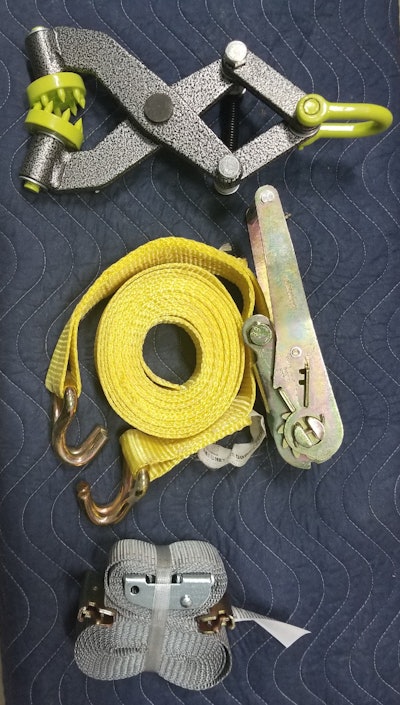 Northern Tool’s model 119312 “Brush Grubber” is around $80, McNeal says. to “save yourself a bunch of trouble pulling out most pallets.” He recommends straps from U.S. Cargo Control to pull loads out of your truck and to safely secure your cargo. E-track can be bought from most any Utility Trailer dealer and bolted to the floor of your van, with plywood in between to level the floor out between the E-tracks. “Never move an inch,” he adds, “without properly securing your cargo.”
Northern Tool’s model 119312 “Brush Grubber” is around $80, McNeal says. to “save yourself a bunch of trouble pulling out most pallets.” He recommends straps from U.S. Cargo Control to pull loads out of your truck and to safely secure your cargo. E-track can be bought from most any Utility Trailer dealer and bolted to the floor of your van, with plywood in between to level the floor out between the E-tracks. “Never move an inch,” he adds, “without properly securing your cargo.”5. ‘Brush grubber’ as pallet slider tool
Built for the purpose of “latching on to small trees to pull them out of the ground with trucks,” these work particularly well also, McNeal says, as a cheater tool to grab your center pallet to help pull it out — “it doesn’t matter how heavy the skid is, this will work” with a strap and a hook.
6. Custom-sized mattress
McNeal purchases twins from Spine Align in his native Holland, Mich., at eight inches thick and 72-inches long. “Get a real mattress, where you’re not going to wake up with sore spots,” he says. “Drivers will thank you.”
(When you max out space in the cargo area with freight, position the mattress against the wall.)
7. Microwaves/refrigerators/AC units
Rather than the “super-expensive RV types,” McNeal recommends cheaper, typical consumer types that can be purchased most anywhere. For the window-unit-type AC, he’s built a custom door he has manufactured for his operation especially to fit it, though, keep in mind, and run it from the small gasoline-powered generator.
Also, he adds, “Insulate the van from top to bottom and use the generator, save more money on fuel to run it.” For insulation, the spray variety works well, but “it’s tougher to finish off,” McNeal says. “If you don’t have insulation in wintertime, you’ll get condensation,” creating rust issues.
McNeal “finishes the interior sides with oak interior” in an attempt to “give drivers a nicer place – and when customers open the back door to put the cargo in, they go, ‘this is someone I can trust.'”


